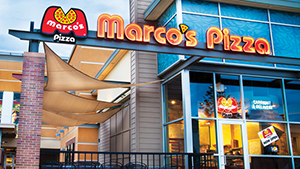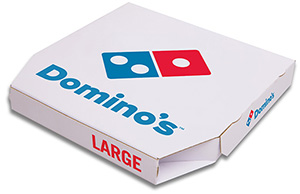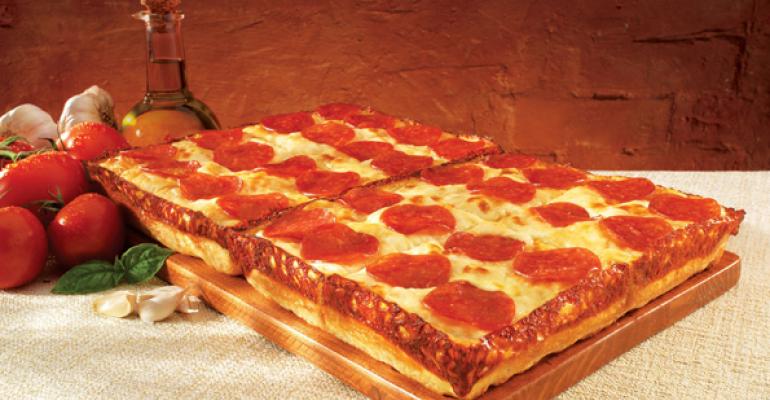Despite intense competition from grocery stores and burgeoning fast-casual pizza players, traditional pizza chains have been outperforming the overall restaurant industry in recent quarters.
Publicly traded pizza chains averaged same-store sales growth of more than 6.4 percent in the fourth quarter of last year, and based on the 14.5-percent first-quarter sales growth at Domino’s Pizza Inc. — its best domestic result in at least 16 years — that performance has accelerated so far this year.
Privately held chains have also been performing well. Madison Heights, Mich.-based Hungry Howie’s same-store sales have risen 10 percent so far this year, CEO Steve Jackson said.
“It’s really a great time to be in the pizza business,” Jackson said.

Toledo, Ohio-based Marco’s Pizza is on track to add 150 locations this year, and finish with more than 700 units. Net sales last year rose 41 percent.
How are pizza chains seeing such success? By making their business models convenient, enabling them to take advantage of their natural value to court families and groups looking to feed a lot of people for less money.
“It’s a community food,” said Bryon Stephens, Marco’s president and chief operating officer. “Whether it’s family, friends or neighbors, we add to the value equation and have food everybody can share.”
It’s a remarkable comeback from six years ago, when a strong argument could be made that Americans had reached their fill of pizza.
Domino’s sales fell for three straight years (2006-2008), and at one point its stock was trading at less than $2 a share. Pizza Hut’s sales fell 12 percent in the fourth quarter of 2009. And in 2011, Round Table Pizza, Sbarro and Giordano’s all filed for bankruptcy.

The sector was loaded with competitors. Grocery stores were making inroads into the business with a huge selection of higher-quality frozen pizzas, as well as their own offerings. Convenience stores started selling pizza, too. And the U.S. was saturated with pizza restaurants.
Amid intense competition, pizza chains reworked their business models, improved their menus, found the right value message and worked hard to make their restaurants more convenient.
In particular, they’ve leveraged technology to make it remarkably easy to order a pizza without being in danger of being put on hold.
Pizza chains were among the first in the restaurant business to see technology as a way to make their operations more efficient and customer friendly. In recent years, they’ve intensified technological adoption.
Both Domino’s and Papa John’s get at least half of their orders through digital channels. Domino’s has apps that let customers order through a smartwatch or even a television.
Embracing the tech revolution
The increased popularity of pizza has coincided with the growth of smartphone use. According to eMarketer, the number of smartphone users has nearly tripled between 2010 and 2015.
At Marco’s Pizza, about 17 percent to 20 percent of sales now come through digital channels, but that percentage is rapidly growing. At some newer locations, the rate is as high as 60 percent.
“The pizza category is one of the first to get on board and embrace the whole tech revolution,” Stephens said.
The chain’s Digitale project lets customers order pizzas over the Internet and by smartphone, but it also tracks those orders to customize its relationship to those customers. It also helps find similar customers, Stephens said.
“We understand who they are and what they’re buying from us,” he said. “We get to social, digital marketing that allows us to communicate to them more frequently. Consumers are more fragmented than ever on where they’re getting their media. We’re spending a lot of money against those initiatives.”
Hungry Howie’s put online ordering in place five or six years ago, and its use is increasing 30 percent to 40 percent every year, Jackson said. The 560-unit chain has enjoyed 20 straight quarters of same-store sales growth.
“We say that online ordering is a big part of that,” Jackson said.
He also admits that he is a relatively recent convert.
“When online ordering started to service, personally it took me a little time to get on board,” Jackson said. “You pick up the phone, call and order a pizza. Or I have to find my computer, turn it on and boot it up. Who’s going to do all that?
“The real transition happened over the last five years with the iPhone, apps. Samsung and Android have done a good job to make our phones so important that we can’t live without them.”
The adoption of technology might finally be shifting the advantage to pizza chains. For years, chains ceded a large part of the market to independents, even as other restaurant sectors consolidated. But many executives now say that technology has shifted the advantage to chains.
“Chains’ tech advantages has led to the erosion of independents’ market share,” Stephens said.
The ease of pickup isn’t just limited to technology. Detroit-based Little Caesars shifted its strategy a decade ago to $5 Anytime Pizza, letting customers pick up large pizzas for the price of a Subway Footlong sandwich. And Papa Murphy’s took take-and-bake pizza and made a chain out of it.
The convenience of buying pizza has combined with the sector’s traditionally strong value, particularly for families and groups who see pizza as a more affordable option.
A family needing a quick meal, for instance, can order a pizza or two for not much more than $10 in many cases. And now they do so easily, either by picking it up directly or ordering via smartphone.
That’s a value that has been in place for years. Jackson recalled his days working at Dairy Queen, when ice cream cones cost 10 cents to 35 cents. Today a cone is $2.
“I was delivering pizza in 1972,” he said. “At the time, it was $3 for a pizza. The competition is selling large pizzas for $5 today. If you take the analogy of Dairy Queen or coffee, that pizza should be going for around $50.”
Contact Jonathan Maze at [email protected].
Follow him on Twitter: @jonathanmaze

